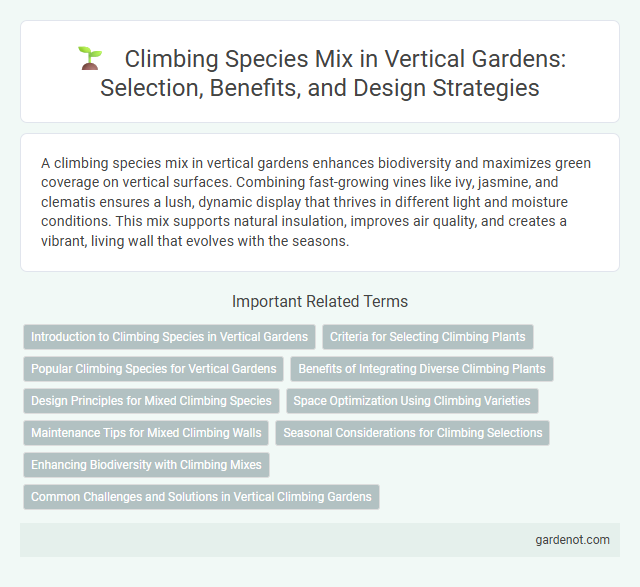A climbing species mix in vertical gardens enhances biodiversity and maximizes green coverage on vertical surfaces. Combining fast-growing vines like ivy, jasmine, and clematis ensures a lush, dynamic display that thrives in different light and moisture conditions. This mix supports natural insulation, improves air quality, and creates a vibrant, living wall that evolves with the seasons.
Introduction to Climbing Species in Vertical Gardens
Climbing species in vertical gardens provide essential coverage and aesthetic appeal by utilizing structures to grow upward, maximizing limited space. Popular climbing plants such as ivy, jasmine, and clematis exhibit rapid growth and adaptability, making them ideal for vertical installations. These species contribute to improved air quality and thermal regulation while adding vibrant textures and colors to urban environments.
Criteria for Selecting Climbing Plants
Selecting climbing plants for a vertical garden involves evaluating growth habit, light requirements, and maintenance needs to ensure optimal coverage and sustainability. Hardy species with strong attachment mechanisms, such as tendrils or aerial roots, provide reliable support on vertical structures. Preference for native or adaptive plants enhances resilience against pests and climate variations, promoting long-term garden health.
Popular Climbing Species for Vertical Gardens
Popular climbing species for vertical gardens include English ivy (Hedera helix), which thrives in shade and requires minimal maintenance, and climbing roses, known for their fragrant blooms and vibrant colors. Clematis varieties are favored for their diverse flower shapes and prolonged blooming periods, while jasmine provides a sweet scent and fast growth ideal for covering trellises. Wisteria offers dramatic cascading flowers and robust growth, making it a striking choice for large vertical structures.
Benefits of Integrating Diverse Climbing Plants
Integrating diverse climbing plants in a vertical garden enhances air purification by increasing the variety of foliage surfaces that filter pollutants. This mix boosts ecosystem resilience, as different species attract various pollinators and natural pest controllers, promoting balanced plant health. A diverse climbing species selection also maximizes space efficiency and visual appeal, creating layered textures and colors that enrich the vertical landscape.
Design Principles for Mixed Climbing Species
Incorporating a climbing species mix enhances vertical garden biodiversity and aesthetics by leveraging complementary growth habits and foliage textures. Design principles emphasize selecting species with varied root adhesion mechanisms, growth rates, and seasonal behaviors to ensure balanced coverage and minimize competition. Strategic layering and spatial arrangement optimize light exposure and structural support, promoting healthy coexistence and dynamic visual interest throughout the year.
Space Optimization Using Climbing Varieties
Climbing species such as ivy, jasmine, and clematis maximize vertical garden space by growing upward rather than outward, making them ideal for small or limited areas. These plants effectively cover walls and trellises, enhancing greenery while minimizing ground footprint. Incorporating a mix of fast-growing and flowering climbers optimizes aesthetic appeal and functional coverage for vertical gardening.
Maintenance Tips for Mixed Climbing Walls
Maintain mixed climbing walls by regularly pruning fast-growing species such as ivy and clematis to prevent overcrowding and ensure balanced growth. Inspect support structures frequently for stability and clear debris to promote healthy air circulation and reduce pests. Apply slow-release fertilizers biannually to provide consistent nutrients tailored to the diverse needs of combined climbing plants.
Seasonal Considerations for Climbing Selections
Climbing species for vertical gardens should be selected based on their seasonal growth patterns and climate adaptability to ensure year-round visual interest and structural coverage. Evergreen climbers like English Ivy provide consistent greenery, while deciduous varieties such as Clematis offer vibrant seasonal blooms and foliage changes. Considering factors such as frost tolerance and flowering seasons supports optimal growth cycles and maintains vertical garden vitality throughout all seasons.
Enhancing Biodiversity with Climbing Mixes
Climbing species mixes in vertical gardens significantly enhance biodiversity by supporting diverse insect and bird populations. Incorporating native climbers such as ivy, clematis, and wisteria creates varied habitats and improves ecological balance. These mixes promote urban greening by increasing plant complexity and providing seasonal flowering and shelter opportunities.
Common Challenges and Solutions in Vertical Climbing Gardens
Climbing species in vertical gardens often face challenges such as inadequate support structures, insufficient sunlight, and pest infestations. Solutions include installing robust trellises or wire frameworks, selecting species adapted to varying light conditions, and implementing integrated pest management practices. Regular pruning and training of vines improve airflow and reduce disease risks, ensuring healthy vertical growth.
Climbing species mix Infographic

 gardenot.com
gardenot.com